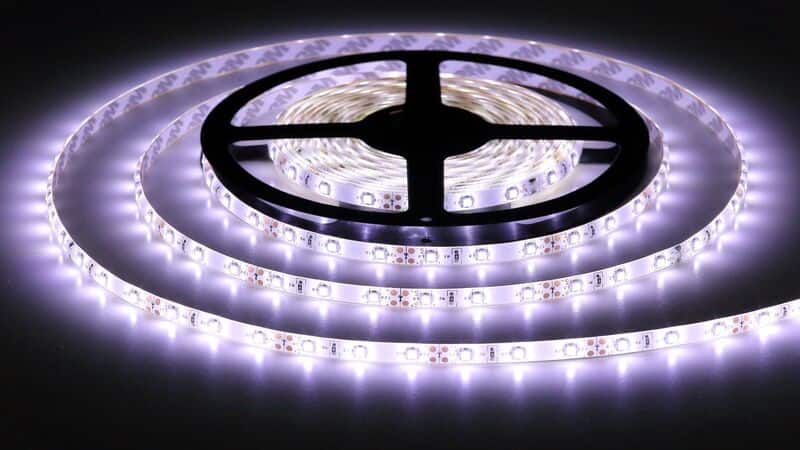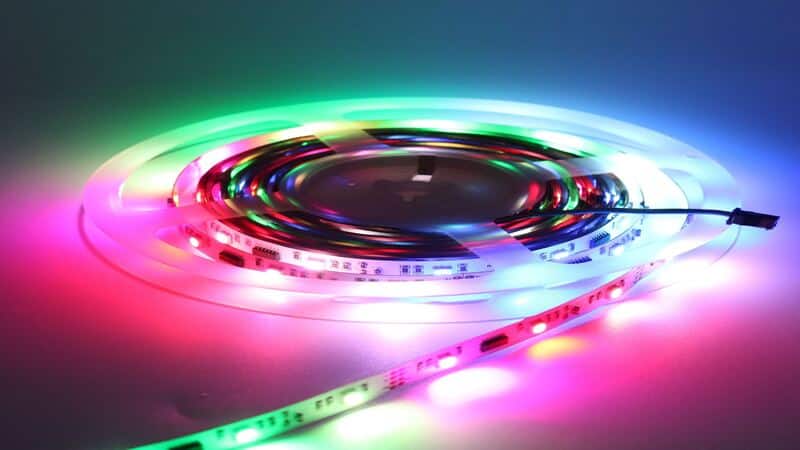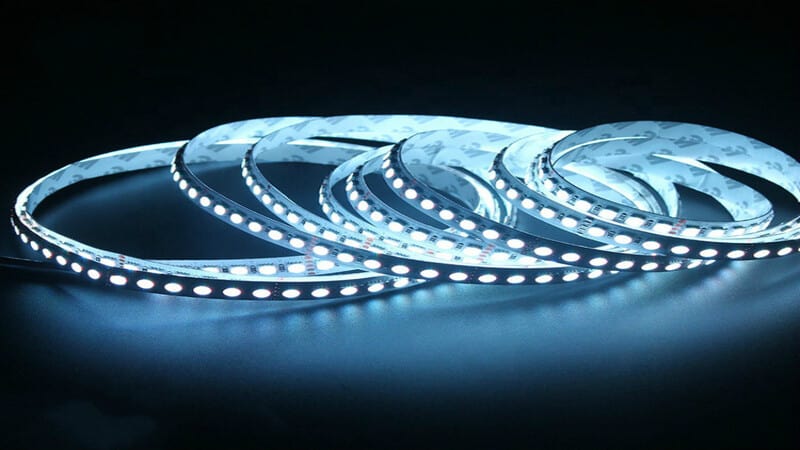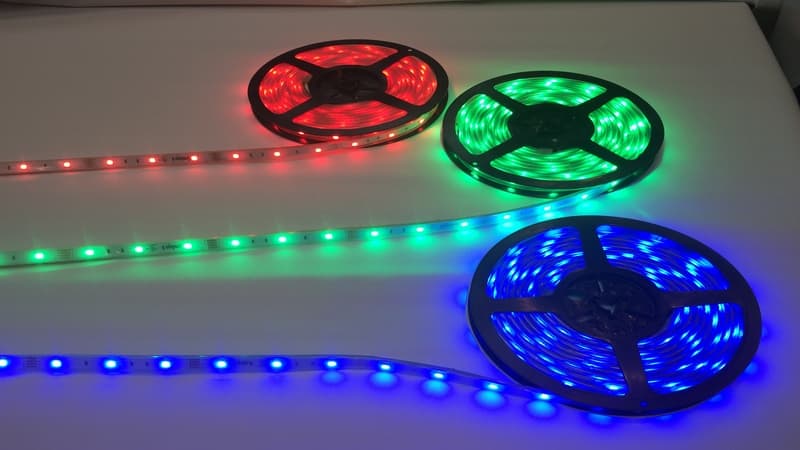Addressable LED strips bring lighting designs to new heights never before we’ve seen such a level of customization with colors, brightness, and timings.
You can use them for designing mesmerizing light shows or have a fun little DIY project in your room. It’s a perfect fit for all; the only limitation is YOUR imagination.
However, digital addressable LED strips are NOT easy to set up and may need expert guidance. To help you with that, we made this ultimate guide to addressable LED strips that covers all your questions and queries regarding addressable LED technology.
Let’s dive into it.
What Is an Addressable LED Strip?

Addressable LED strips have LEDs that can be controlled (addressed) individually, giving you tons of lighting design flexibility.
Normally, an analog LED strip can change one color at a time. But with an addressable LED strip, you can program each LED individually and control its color, temperature, hue, and brightness.
This helps create amazing lighting effects like chasing lights, meteor showers, moving fades, and many more. Mainly used in applications where a high degree of control is required, like stage lighting in concerts.
You can program each LED using computer code and make a custom lighting show or use a pre-defined set of libraries to get awesome effects.
At first glance, you’ll notice that addressable LED strips have three parts, LED chips, the controller or microcontroller, and a power supply.
Programming and controlling addressable LED is difficult, but its flexibility in custom lighting designs is immense.
Individually Addressable LED Strip vs. Addressable LED Strip
Addressable LEDs strip may have LED chips that can be controlled individually or in a group of 3 or 6 LEDs. Individually addressable LED strips let you control every LED, making them the most dynamic lighting option available.
Simple addressable LED strips give lesser control as you can only control groups of LEDs at once. However, they are still far ahead of analog LED strip lights.

How Do Addressable LED Strips Work?
Understanding how addressable LED work is critical to having the best lighting design for your project. We’ll keep it simple so you don’t get caught up in too many technical details.
Addressable LED strips let you control each LED (chip) individually, which is made possible by combining an integrated circuit chip (ICs), a controller, and a power supply.
Each LED has its standalone integrated chip (IC) responsible for changing that particular LED’s color and brightness.
The addressable LED strip light is arranged in groups of 3 or 7 chips wired in series. There is a cutting point after each group which is how you can get the desired length of the LED strip.
Next up is a microcontroller that controls each IC of the LED. It does that by utilizing data channels that connect IC with the controllers.
Traditional RGB LED strip doesn’t have controllers with data channels and instead is connected with R, G, B, and + pins that can only send single commands.
All of this is powered by a power supply. It uses a low-power DC supply, typically 12V or 24V.
Moreover, two control protocols, DMX512 and WS2812, are available in the market.
DMX512 is more for professional use, like big light shows, while WS2812 is beginner-friendly and typically used in small-scale projects.
5 Ways to Categorize Addressable LED Types
1. Based on Integrated Controller (IC) Chip
You’ll probably find these names printed on standard LED addressable strips, which are actually the names of IC chips.
A built-in IC chip controls individual LEDs’ colors and brightness levels. So, it plays a pretty important role. Some of the popular types are as follows.

WS2812B
WS2812B uses one wire communication protocol offering a wide range of color options. Popular microcontrollers like Raspberry Pi and Arduino can control these strips.
Furthermore, it’s the most commonly available and inexpensive addressable LED strip type. It’s a favorite pick for LED hobbyists and enthusiasts.
APA102
Next up is APA102 addressable LED strip that uses a two-wire communication protocol allowing a higher refresh rate resulting in smoother transitions, animations, and lighting shows.
SK6812
SK6812 is similar to WS2812B in the sense that it only uses one-wire communication but has voltage-independent colors and brightness levels, which is really convenient.
Voltage independence means that the drop in volts doesn’t affect the colors of the SK6812 addressable LED strip over a specific voltage range.
Moreover, it offers a larger color gamut and higher accuracy.
LPD8806
LPD8806 addressable LED strip provides a higher refresh rate(RR) and pulse width modulation (PWM) rate resulting in better color resolution and smoother transitions than all the above types. RR AND PWM are two performance-measuring standards of LED circuits.
2. Based on Signal Protocols
The different types of addressable led strips are based on communication signals (data). Each with its unique properties.
DMX512 LED Addressable Strip
Digital Multiplex(DM) 512 means that more than five hundred data channels can be controlled at a time, making this addressable led strip the most programmable and versatile among all types. It enables you to perform complex lighting tricks and animations. By the way, learn about the difference between DMX and DALI lighting control.
DMX512 LED strips are compatible with the DMX controller. However, traditionally led strips require a separate decoder which makes DMX512 superior.
If one LED chip burns out, it doesn’t affect the other bulbs, and they work perfectly fine.
DMX512 is a universal digital protocol for lighting equipment, but its great controllability makes it harder to wire.
It is also the most expensive compared to other types. Though, its high quality, low interference, and long-distance communication make it worth every penny.

SPI Addressable LED Strip
SPI, short for “serial peripheral interface,” is another subcategory of an addressable led strip that uses synchronous serial communication protocol for data transfer for communication.
Unlike DMX512, which uses a synchronous parallel interface to create more complex lighting shows, the SPI strip is relatively simpler.
It can offer a wide range of preset lighting offers that you can select on a remote controller suited for small projects with minimum lighting requirements like decoration.
SPI is not an international protocol, so different manufacturers may end up developing different protocols for their strips.
This simply means that SPI addressable strips can only be controlled by an SPI controller, which the manufacturer recommends.
Subcategories
Single Signal Addressable Strip: As the name suggests, a single signal addressable strip has an IC control area that can transmit only one signal at a time. An IC control area is also called a Pixel. It’s a combination of an LED chip and an IC circuit.
When a single LED (pixel) burns out, the rest of the bulbs attached next to it also stop working.
Dual Signal Addressable Strip: A dual signal addressable strip has an extra clock channel that lets you control each LED’s ON/OFF time. Like the first type, if one bulb along the strip stops working, the others will also shut down.
Breakpoint Resume Addressable Strip: Breakpoint Resume addressable LEDs have a backup and default data line. This simply means that if one of the LED chips burns out, the rest will still work. It’s an upgrade to a single signal addressable led strip and utilizes a four-channel LED driver.
Still confused? Here is an easy breakdown of the different categories with their examples. Table 1 is about DMX512 vs SPI Addressable LED Strip, and Table 2 shows examples of dmx512 LED strips and SPI LED strips.
| Signal Protocol | Wiring | Compatibility | Reliability | Anti-interference | Cost | Application |
| DMX512 | Hard | Good, Universal IC protocol | High, Breakpoint transmission | Good long-distance communication | High | Stage lighting, large light shows, ads |
| SPI | Easy | Inferior,Different protocols | Breakpoint resume but discontinue after two breakpoints | Inferior, affected by strong current/magnetic disturbance | Low | Small scale decoration |
|
Signal Protocol |
Category |
Examples |
|
DMX512 Addressable LED Strip |
Universal/Same protocol for different DMX512 ICs |
UCS512, SM17512 |
|
SPI Addressable LED Strip |
Built-in IC models |
WS2812B, WS2813, WS2815B, SK6812, SK9822, APA102, CS2803, CS8812B |
|
|
External IC models |
WS2801, WS2811, WS2818, UCS1903, TM1814, TM1914, TM1812, CS8208, CS6816, CS6814, LPD8806 |
|
|
IC models with breakpoint resume function |
WS2813, WS2815B, CS2803, CS8812B, WS2818, TM1914, CS8208 |
|
|
IC models without breakpoint resume function |
WS2812B, SK6812, SK9822, APA102, WS2801, WS2811, UCS1903, TM1814, TM1812, CS6816, CS6814, LPD8806 |
|
|
IC models with clock channel |
SK9822, APA102, WS2801, LPD8806 |
|
|
IC models without clock channel |
WS2812B, WS2813, WS2815B, SK6812, CS2803, CS8812B, WS2811, WS2818, UCS1903, TM1814, TM1914, TM1812, CS8208, CS6816, CS6814 |
3. Based on the Voltage
Addressable LEDs are available in 5V, 12V, and 24 V voltage ratings. For longer strip runs, a higher voltage rating of 24V is preferred so you won’t experience voltage drop along the strip.
4. Based on Colors
Addressable LED strip lights can produce any color imaginable with a combination of red, blue, green
(RGB) and white light (W). Here are some standard color options you can choose
from.
RGB
Single 3-channel chip.
RGBWA
Single 4-channel chip. RGB with white LEDs.
RGB+W
Single 3-channel RGB chip with a separate chip for White LED.
RGB+CCT
Single 3-channel chip with a separate 2-channel chip consisting of cold white and warm
white LED.
RGBCCT
Single 5-channel chip with RGB, CW, and WW LEDs
5. Based on Chip Size

Finally, different integrated circuit (IC) chip sizes differentiate digitally addressable LEDs. They are the four digits numbers printed on the IC chip, for example, SMD 5050 and SMD 2835. These represent the size in millimeters (mm).
So, a 5050 IC chip is 5mm by 5mm with a surface area of 25 mm.
Remember, a larger surface area of an LED IC chip doesn’t necessarily mean a brighter light. In fact, a 5630 chip puts out more light than a 5054 chip, even though it has a smaller surface area.
Other factors that influence the lumen output of an LED are circuit design, power supplied, and material.
However, size does play a role in the placement of LED chips onto the strip. The narrower chips can be placed closely together, resulting in smooth, light output, contrary to bigger chips that need to be spaced further apart.
But a bigger chip can easily fit multiple diodes in a single chip, creating more dynamic lighting.
How to Choose the Right LED Strip?
Choosing the right digitally addressable LED strip depends on various factors. Knowing
them will increase your chances of buying a suitable product for your project.
1. Find the Right Voltage: 5v, 12V, or 24V; Which Is Better?
Typically, addressable LED strips run on 5v, 12v, and 24v supplies. We recommend going for the 12 or 24v option for large installations as it prevents voltage drop in the LED strip.
A voltage drop occurs due to the inherent electrical resistance of the wire. This resistance causes voltage loss in the circuit.
The longer the wire is, the higher the resistance will be. You can’t do anything about the voltage drop except to use a higher voltage power supply.
LEDs closer to the power supply get the most voltage and shine the brightest, but the bulbs in the end, suffer from the voltage drop resulting in diminishing brightness.
Lower voltage LED strips have shorter cut lines. That’s because LED chips are wired in groups on the strip.
A 5 V strip has one-, a 12 V strip has three- and a 24 V strip has seven- LEDs in one group.
So, for smaller projects with a higher number of bends, we recommend low-voltage addressable strips like 5v or 12v because they have closer cut lines.
2. Copper Circuit Thickness
The flexible strip on which the addressable LEDs are mounted is actually a long, flexible circuit board.
This strip (circuit board) is lined with a copper layer connecting all the circuitry and dissipating residual heat.
We know through basic physics that a conductor with greater thickness will offer lesser electrical resistance resulting in a lower voltage drop.
So, we recommend an addressable LED strip with a higher copper amount. Typically, the copper in LED strips is measured in ounces per sq. ft.
For small-scale projects, you can do away without considering this, but for large-scale projects, we recommend asking the retailer for complete details about copper content in the addressable LED strip.

3. Brightness and CRI
How bright an LED is directly related to its power supply. The higher the power is, the brighter the light will be.
Color rendering index (CRI) measures how well an artificial light source reproduces the object’s original color.
Sunlight has the highest CRI value of 100, and all other light sources are measured against it. Cheap addressable LEDs tend to have poor CRI values, which can destroy your lighting project. So, always invest in products with a CRI rating of 85 or higher.
4. Luminous Efficacy
A common misconception is that the brighter the LED light is, the more powerful and efficient it is.
But that’s not the complete story. An LED light can produce high lumens if given enough power supply, which is just a waste of energy.
A better way to measure the efficiency of an LED strip is by a ratio of luminous flux to power, known as Luminous Efficacy.
It is usually mentioned in the product specs, but if they ask the retailer about it. LED strips with higher luminous Efficacy produce brighter light by consuming minimum energy and dissipating less heat.
5. Dustproof and Waterproof
The LED power supply must be dust and waterproof, especially if you install it in concealed places, like behind the drywall.
The addressable LEDs, which are rated IP65-68, should be used for extra safety.
6. LED Density
The number of LEDs present in one meter (unit) of the addressable LED strip is known as the LED density. Higher density makes lighting brighter and transitions smoother, but it also increases power consumption.
7. Control Protocol Type
Lastly, you need to consider the control protocol type like DMX512 or SPI. You can go through the various options we’ve discussed above and choose the best suited for your project.
How to Install LED Strip?
We recommend three great ways to install LED strips for your projects.

Adhesives
Adhesives and sticky tape are great ways to attach the LED strips to the surface. However, this method is best suited for DIY small-scale projects like lighting up your room or a music studio.
Aluminum Channels
LED channels are aluminum rails with diffusers in which LED strips are placed. It acts like a shield for the LED strip and gives off a smooth, even light output which is great for sophisticated decor. It’s fairly easy to attach rails to any surface.
Aluminum channels hide the electrical wiring, giving your place a minimalistic and clean look.
Buckles
Use buckles or mounted clips to install outdoor LED strips. For outdoor use, adhesives may not be effective against the weather, so clips are a better option.
Dealing with Bends and Corners
Managing LED strips at bends and corners can be a frustrating experience. Here are some tips for easy installation without much cutting and bending of the strip.
Tip 1 Gentle Bend
Guide the LED strip along the corner and let it take its natural shape. Do not force the bend. Place hot glue for extra stickiness.
Some people also try to fold the LED strips at a 90 degrees angle. However, it can damage the strip.
Tip 2 Wire Connector
Cut the LED strip into two parts at the cut line. Use a wire connector to connect both strips. Though efficient, this will leave the corner with no light. To counter this, use an aluminum channel or a diffuser to get even light.
How to Wire Addressable LED Strip?
The best way to connect two LED strips together is by soldering the end of the connector. The output of one LED strip is connected to the input of the second, and the process continues. Connect one end to the power supply, and the whole strip will light up.
DMX512 Addressable LED Strips
Start by setting the dmx512 address into DMX512 ICs. You have to use an address writer to achieve this. Once the address is set in the DMX controller, it will save all the data of the LED IC even when the power is turned off.
SPI Addressable LED Strips
SPI is different than DMX512 and doesn’t require setting up the address.
SPI isn’t a standard style, and many manufacturers tend to use their own design. Typically, an SPI addressable LED will have a data channel, a spare data channel (only for breakpoint resume type), clock channel.
The channels on the PCB of an SPI LED strip are marked with the letter D for the data channel, the letter B for the spare data channel, and the letter C for the clock channel.
How to Connect Addressable LED Strip to Power Supply?
LED strips operate on low voltage DC so you simply can’t put it in the main AC power supply as this will cause them to burn out.
Instead, use high-quality AC to DC power supply. A rule of thumb is to use a power supply of 20% more rating than the expected power consumption of LED strips, as this will counter the voltage losses.
Make sure to match the voltage of the LED strip and the power supply. Underpowered or overpowered LEDs don’t last long.
Powering Long LED Strips
You’ll certainly face voltage drops for a longer LED strip and may need more than one power supply.
Tip 1
You can attach the power supply to the middle of a long LED strip. The power is evenly distributed on both halves, and there won’t be any voltage drop.
Tip 2
If connecting the power supply in the middle doesn’t solve the voltage drop, then you may need Power Injections.
It’s simply running extra wires to places that actually need them. You can connect these wires to a single or multiple power supply.
In the case of a digital addressable LED strip, it’s safe to connect the power supply directly to the positive and negative terminals of the strips because the individual microcontroller of each LED regulates the voltage.
For multiple power supplies, just remember not to connect the positive wires of two adjacent power supplies, as it can cause a fire.
Tip 3
Make sure to use thick wires for larger projects, as they offer the least resistance.
How to Control Addressable LED Strips
DMX512 LED strip requires a DMX controller, and the SPI LED strip needs a specific SPI controller. These controllers are not compatible with each other.
To control digitally addressable LEDs, you need a computer/controller like Arduino or Raspberry Pi to process all the code and signal the LED microcontroller on the strip.
You’ll need a separate supply to run the program on the computer and control the addressable LEDs.

Troubleshooting Addressable LED Strips
Addressable LED strips are fun to work with on DIY projects, but like any other electronics, they can run into problems. Here are a few things you can do to troubleshoot a digital addressable strip.
LED Strips Not Lighting Up
If your LED strip is not lighting up at all, go and check the power supply. If it’s working fine, check for any visible damage to the wires connecting the LED strip to the power supply.
If there is no wiring issue, then you may have a faulty LED. Use a multimeter to check the voltage across each LED chip.
Semi-lit LED Strip
If only a few LEDs are lighting up and the rest are either dim or not working, then you have a voltage drop or signal loss issue. Make sure the wiring is ok, and use a slightly higher-rated power supply.
Inconsistent Colors
Digital addressable LEDs may show inconsistent colors if there is a problem with color calibration during programming or coding. Ensure the program code’s color values are consistent across the entire strip.
Flickering LEDs
If your LEDs are flickering, you may be facing an error related to the refresh rate of the strip. Access the code and ensure the refresh rate is set correctly and the signals reach all the LEDs on the strip.
Overheating
If your addressable LED strip is heating up, you are using a poor-quality power supply or a higher power than recommended.
See the details about connecting the power supply above. Ensure you keep the strips ventilated and don’t run them at full capacity for an extended period.
Where to Buy Addressable LED Strips?
If you’re a first-time buyer or just want to improve your order, here are a few things you must consider when buying addressable LED strips for your project.
- Get a clear idea about your project and discuss it with your vendor. You can look for design ideas on Google and YouTube and share them with the manufacturer.
- Choose a Chinese vendor that offers customization of LED strips according to your requirement.
- Make sure there is active communication between your vendor and the lighting designer. Usually, designers implement LedEdit and Madrix platforms to program addressable LED strips.
- Once you place the order, the manufacturer will send the product with wiring diagrams.
- LED strips are available at many prices. Low-quality LED strips may work fine in the start, but they burn out quickly and don’t offer customization on the level of high-quality ones.
Final Thoughts
Kudos! If you stuck around till the end. After going through our guide, we are positive that you now have a firm grasp on the working concept of digitally addressable LED strips.
We’ve first covered the working of the addressable LED strip and how to differentiate them with so many available options. Later we discussed installation and ways to get the best product in the market. With this knowledge and deep survey, you can find the best LED product for your project.
Wait! Before you leave, let us share with you a place where you can get all your LED lighting needs under one roof.
Best Place to Buy High-Quality LED Strips
Are you looking for an addressable LED strip manufacturer that can help with your project?
RC Lighting is a leading Chinese manufacturer of addressable LED strips. Our products are manufactured in dust-free and high-tech plants under the watchful eye of expert technicians and engineers.
You can choose from a variety of high-quality LED indoor and outdoor lighting products in our catalog at market-competitive rates.
Got a unique request? We offer customization offers to our clients all across the globe.
Our LED addressable lights are durable, long-lasting, and available in various colors. Moreover, our products comply with the highest international quality standards.
RC Lighting offers 24/7 customer service, and you’ll also get a FREE project evaluation. So what are you waiting for?



